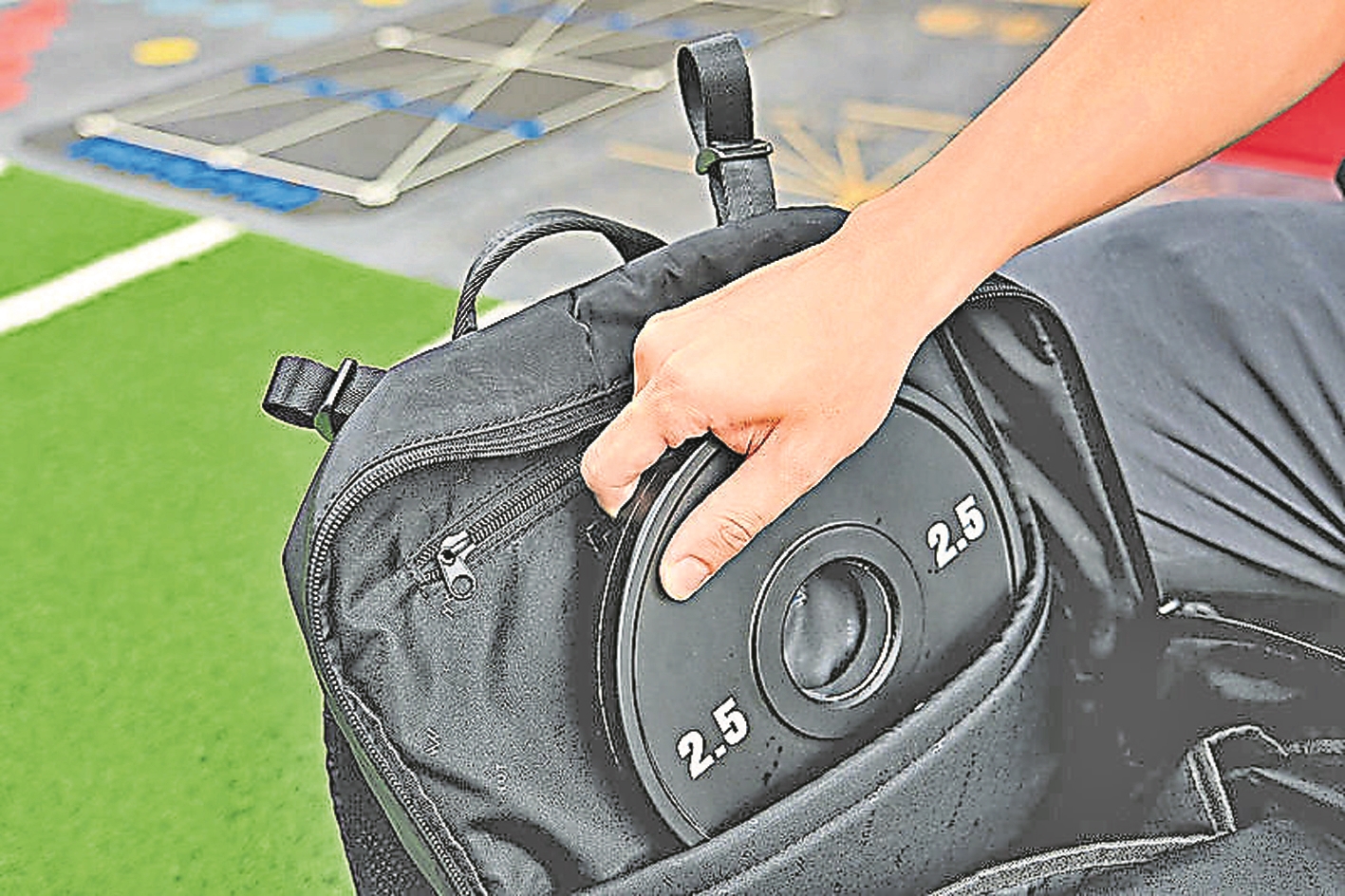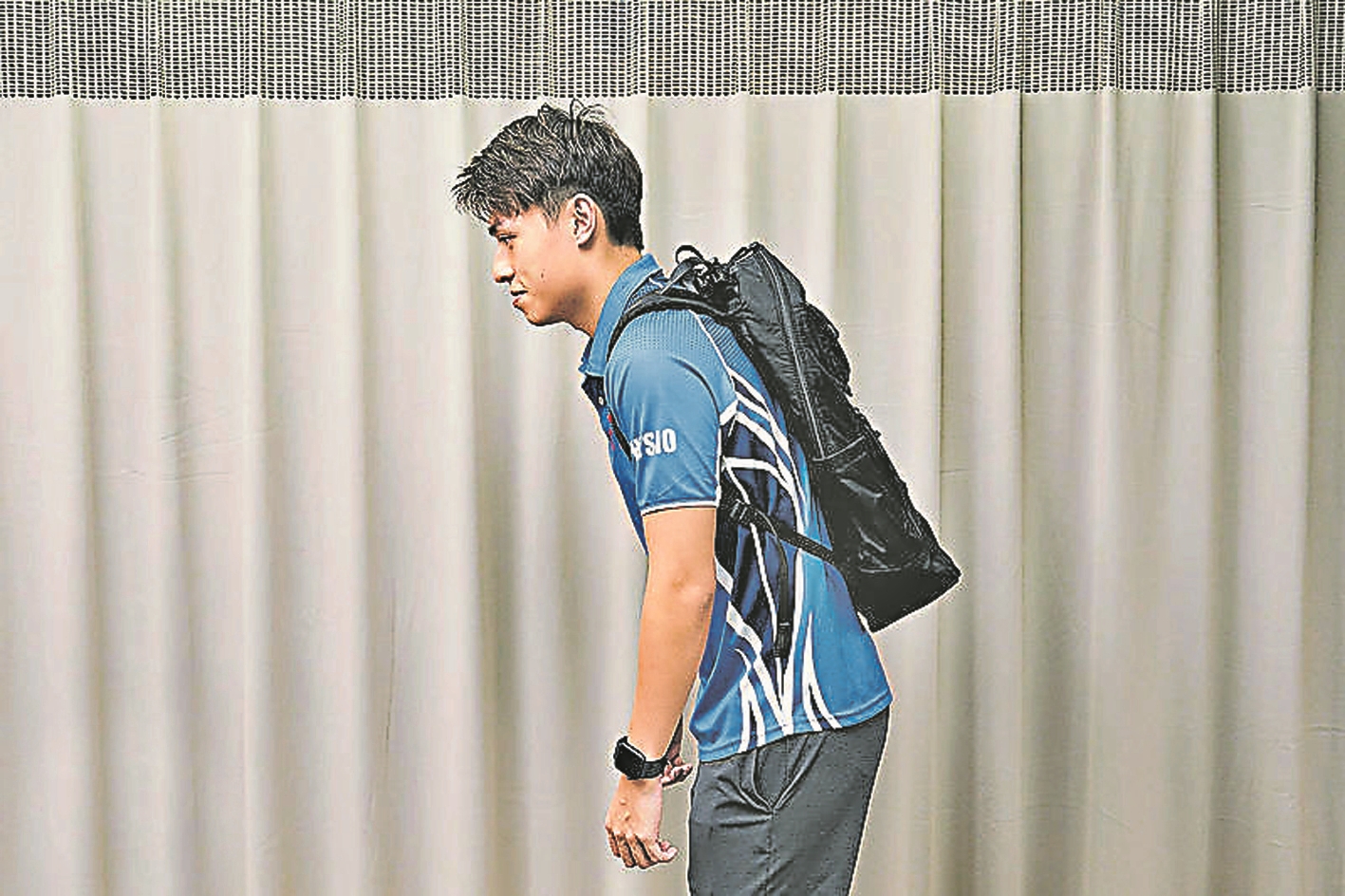[Sports and Health Special Topic]Walking with a weighted backpack is easy to get started Rucking exercises for the whole body to prevent osteoporosis
[ad_1]
(Hong Kong News) Searching for #Rucking on social media, there are many training videos of soldiers carrying large camouflage backpacks and walking with heavy loads. At the same time, there are also short sports videos of ordinary people wearing weight-bearing vests or walking with heavy-weight backpacks. This method of military training has recently become popular. It became an internet sensation and the related video has been viewed more than 20 million times!
There are many variations of walking exercises, something as simple as walking with a weighted backpack can actually enhance your exercise.
The weather is cool, it’s time to pack your backpack and hit the road! Rucking is easy to get started and can exercise the whole body, control weight, and prevent osteoporosis.
Rucking is a training method of wearing a weighted backpack or vest. It first appeared in the military training ruck march. The purpose is to strengthen the cardiopulmonary function of soldiers and ensure that they are well-equipped and protected while escaping. In recent years, it has become popular among the people and transformed into Popular sports for urban men and women. Many foreign netizens took photos to share their daily rucking days, and also talked about the benefits of exercise, suggested postures, etc., and shared the fun of exercise.
Help improve endurance and cardiopulmonary function
Physical therapist Zhao Zhiyi pointed out that there is a reason why rucking became so popular. First of all, it’s easy to get started. “Basically, just a backpack and some heavy objects are enough, such as cans, large water bottles, etc.; in addition, rucking has many changes. In addition to running and walking, it can also be integrated into the workout, such as doing lunges with a backpack, Squat for a more intense workout.”
Liu Minchang, a professor at the Wong Chung-Kun Sports Medicine and Rehabilitation Center of the Chinese University of Hong Kong Hospital, pointed out that this popular sport in foreign countries is also very suitable in Hong Kong. “Many people like to walk in the mountains. In fact, they can incorporate it into it and practice when the weather is cool. .”
Rucking can exercise many muscles in the body. Liu Minchang pointed out that carrying weight on the upper body requires the shoulders, back and core muscles to help maintain movement stability and balance the weight. At the same time, it also places certain demands on the lower limbs such as the calves, quadriceps, and gluteus maximus.
Some studies have found that wearing a weighted backpack can help increase lower limb muscle strength and endurance. Rucking not only places high demands on muscles, but also increases heart rate and oxygen consumption during exercise, which can help improve endurance and cardiopulmonary function.
Weight-bearing properties promote bone health
In addition to building muscle strength, rucking’s weight-bearing properties promote bone health and increase bone density. Zhao Zhiyi explained that “osteoblasts” in bones are responsible for adding new bone tissue, while “osteoclasts” remove old or injured bone tissue. As we age, the decomposition rate of osteoclasts will gradually exceed the bone formation rate of osteoblasts, resulting in a decrease in bone density. When doing weight-bearing exercise, the force on bones increases, stimulating osteoblasts to become active, which helps increase bone density and reduce the risk of osteoporosis.
“For the elderly with osteoporosis, if their joints or cardiopulmonary function can cope with it after being evaluated by a doctor or physical therapist, they can play rucking.”
However, Liu Minchang, who is also a physical therapist, reminds that after bearing weight, there are always higher requirements on cardiopulmonary function. Elderly people may be able to prevent osteoporosis through other exercises.
“Rucking is an excellent exercise for burning calories, and many obese foreigners use it to lose weight.” On a website dedicated to promoting rucking, some people can be seen sharing examples of successful weight loss, and even claimed to have lost 100 pounds through rucking. Losing weight requires a combination of diet and exercise, but as far as rucking is concerned, Liu Minchang quoted research as saying that rucking can consume 50% more calories than ordinary walking without weight-bearing. And the higher the load, the more calories are consumed.
“Although rucking is easy, it may not be suitable for everyone.” Liu Minchang said that people with joint pain, joint degeneration, or heart and blood vessel problems are not encouraged to do this kind of weight-bearing exercise. “In addition, patients with lumbar pain, disc herniation, etc. should also avoid it. If they carry heavy objects, their waist problems may be worsened.
Choosing the right backpack spaghetti strap is not suitable
“Rucking equipment is simple, and you can start traveling at any time with a backpack. But you need to choose the right backpack. Zhao Zhiyi pointed out that rope bags and thin shoulder straps are not suitable because the backpack needs to bear at least 10 to 20 pounds of weight. If the shoulder strap is too small, it will It tightens the shoulders and is uncomfortable; it is recommended to choose a style with wider shoulder straps and padding to help distribute weight and pressure.”
“In addition, try to choose a backpack with a flatter body. Otherwise, after placing heavy objects, the objects will fall backwards, and the body may unconsciously bend forward in order to offset the weight. When the backpack is heavier, it will bend forward, which can easily lead to lower back pain. Backache. It’s best to have an inner compartment in your backpack to keep heavy objects close to your body and as close to your upper back as possible.”
The backpack should also have a chest buckle and a belt. “The chest buckle helps disperse the weight from the shoulders, and the belt can transfer part of the weight to the pelvis, reducing the stress on the shoulders and training the strength of the lower limbs.” What should I put in my backpack? Both said it was very casual, such as sports-specific weight plates and kettlebells, or everyday bags of rice, water bottles, books, etc., which can be used to add weight to the backpack.
In the military training ruck march, soldiers must hold a rifle and carry a backpack weighing at least 35 pounds and walk 19 kilometers in three hours. Most people don’t need to be so strict when it comes to rucking. Liu Minchang recommends starting with a weight of 8% to 15% of your own body weight, and then slowly increasing the weight every 5 to 10 pounds according to the training progress.
“Generally speaking, ordinary people should not carry more than 30% of their body weight, otherwise it will be difficult to complete long-distance walking and it will easily increase physical wear and tear. Beginners can exercise 2 to 3 times a week for 15 to 30 minutes each time until the body adapts. Then slowly increase it to 30 to 60 minutes or more. In addition to lengthening the exercise time and carrying weight to increase the difficulty, you can also increase the walking speed to complete the same walking distance in a shorter time.”
“Walking on an incline is also a progression. Inclines require higher cardiopulmonary function, but they cause greater wear and tear on the joints of the lower limbs. It is not recommended to practice on slopes that are too inclined, and it is more suitable for young people.”


Need to warm up first
It is not advisable to add extra weight
Although Rucking is less difficult, physical therapist Zhao Zhiyi reminds you that you need to warm up and stretch your calves, thighs, and waist. It is also advisable to wear hiking shoes and a pair of socks that absorb sweat and are made of non-slippery material to reduce fatigue during exercise. Move your feet inside the shoes to avoid blisters and avoid the following incorrect postures.
1/Kneel straight
After walking for a long time with a heavy load on your back, the body tends to develop bad posture in order to reduce fatigue. Physiotherapist Zhao Zhiyi reviewed the literature and said that when muscles are tired, some people may straighten their knees to reduce muscle output. He explained that bending the knees when walking can distribute the pressure to the thigh muscles. If there is already a lot of weight on the shoulders, , and the knee bending is reduced when walking, and the pressure is directly borne by the joints, which can easily cause injuries to the knees, hip joints and waist.
2/Land on the soles of your feet
If the entire sole of the foot touches the ground instead of the heel when walking, it will reduce the cushioning effect of the thigh muscles and increase the risk of knee injury. When walking with heavy objects, the body should maintain a neutral posture, and the head, neck, and shoulders should avoid leaning forward too much. When walking, the heels should land first and the hands should swing naturally to reduce discomfort and pain caused by bad posture.
3/Extra weight bearing on hands and feet
In order to enhance the training effect, some people may load additional weights on their wrists, ankles, etc., but Liu Minchang does not recommend it. “When you put the weight on the upper body such as the back, all the muscles below (the back) can be used; but if you tie a sandbag alone, The hands and feet only bear force on some muscle groups, and this may increase joint wear and affect the normal swing of the hands and feet, so it is not advisable to add additional stress.”




Save your bones before the age of 30
Prevent osteoporosis
The human body’s bone density (bone density) reaches its peak around the ages of 20 to 30. Especially in women after menopause, the loss of bone density will accelerate due to reduced hormone secretion.
Many pores will appear in the originally dense bones, showing a hollow and loose phenomenon, making the bones fragile. This is called “osteoporosis”.
Thyroid porosis is a silent disease that usually has no obvious symptoms. Most of the symptoms of middle-aged and elderly patients are only appearance changes such as shortening and hunchback, making it difficult to detect the existence of the disease. Fractures may occur when a slight fall occurs, or when a sudden external force is exerted, such as bending down to carry something.
Key to maintaining bone density
Fractures cause severe pain, eventual disability or immobility, and in severe cases, death. Preventing “osteoporosis” does not start until you are older, because human bones reach their peak “before the age of 30”, and then the bone density (bone stock) decreases year by year with age.
It is important to keep the concept of “bone stock” from a young age. The most important component of bones is calcium. Adequate calcium intake when young is an important key to maintaining bone density (bone stock). Chinese people are reminded to grasp the importance of grasping the bone stock before the age of 30. Start saving your bones to avoid bone loss year by year in the future, causing harm to your health and life.
The World Osteoporosis Foundation points out that increasing bone density by 10% at a young age can delay the onset of osteoporosis by 13 years.
4 tips for preserving bones
4 tips to preserve your bones and teach you what to eat to prevent osteoporosis:
1. Diet to preserve bones: Get enough calcium, starting with dairy products and high-calcium foods. Among them, 240 milliliters (ml) of dairy products contain approximately 240 milligrams (mg) of calcium. Common high-calcium foods include cheese, dried fish, black sesame seeds, traditional tofu and dark green vegetables.
Dark green vegetables have more calcium than ordinary green vegetables. The calcium content of each 100 grams of dark vegetables is more than 75 mg. Common dark green vegetables include: sweet potato leaves, amaranth, kale, rapeseed, mustard greens, Sichuan seven and red cabbage.
2. Exercise preserves bones: Exercise helps bone growth during growth and helps maintain adult bones. The main types of exercise are gravity-defying exercises and muscle-strengthening exercises, such as: walking, jogging, and climbing. Stairs, dancing, rope skipping, mountain climbing, dumbbell lifting (hold dumbbells of about 0.5 to 1 kg in both hands or safety items of equivalent weight).
3. Moderate sun exposure: It is recommended to do outdoor activities and bask in the sun in the early morning and dusk. Moderate sunshine can activate vitamin D in the body, help calcium absorption, and strengthen bones.
4. Good living habits: Maintaining a normal weight and quitting smoking and drinking can effectively slow down bone loss and avoid the occurrence of osteoporosis in the future.
Physiotherapist Jian Wenren develops 3 good walking habits to help you age slowly and energetically
The chaos and turmoil caused by the epidemic, coupled with the loneliness accelerated by online social media, have made living a good daily life a luxury. However, the best way to enhance immunity is to return to the basics of life, including walking and sleeping. Ordinary and natural things like eating and drinking should be done carefully.
How to regain inner peace and physical health during the epidemic? Just start by walking well, sleeping well, and eating well!
The interview took place at about 9 a.m. at the trailhead of the Hushan Creek Trail in Taipei City. The 67-year-old physical therapist Jian Wenren was interviewed while walking along the mountain road. He walked as fast as he could and spoke with great energy. His face was not red and he was not out of breath when taking photos. He flipped easily on the horizontal bar and was as agile as a 6 or 7-year-old child.

If you can walk, don’t take a ride. Take 17,000 steps a day.
Almost all climbers knew each other. People who passed by greeted Jian Wenren and asked him why he was so late today, only to find out that he had already walked down the mountain early in the morning.
Walking is Jian Wenren’s daily routine. He gets up at 4:30 and does health exercises. He goes out at around 5 o’clock and walks the Hushan River Trail. At 5:50, he yells ten times with a group of friends on the mountain and then goes down the mountain. At 6:20 The day starts when you get home and have breakfast and read the newspaper.
After retiring in the past two years, his routine work has become less common. Jian Wenren doesn’t take the bus when he can walk. He almost always walks to the sports center and library near his home. He also walks in the park in the evening, averaging 17,000 steps a day.
Jian Wenren is a well-known physical therapist who takes the promotion of sports and health care as his own mission. Every year before the Lunar New Year, many people have seen the video of his self-written “Ruyi Zodiac Exercise” with a smile on his face in the hospital lobby. He emphasized that health is reversible with correct exercise, a balanced diet, a happy mood, quality sleep, regular work and rest, and good habits. After he turned 50, due to the implementation of the above healthy living guidelines, his body’s flexibility, Muscle flexibility and cardiopulmonary function are better than when they were young.

Enjoy the relaxation of walking alone and love to take others with you
“Walking is the best exercise during the epidemic.” Jian Wenren suggested walking more during the epidemic. He explained that intense exercise will excite the sympathetic nerves, which is bad for immunity. Immunity is the advantage of parasympathetic nerves. When people relax, sleep, rest, and bask in the sun, parasympathetic nerves will be better and their antiviral ability will also be improved.
Walking is gentle, easy to get started, and can be used throughout the body. It is an epidemic prevention exercise suitable for promotion. As long as the posture is correct, the step length and frequency can be adjusted according to oneself; as long as everyone is willing to walk, everyone can benefit from it.
Many important moments in Jian Wenren’s life are related to walking. Jian Wenren, who comes from thousands of miles of countryside, has been walking since he was a child to help his father, a miner, deliver lunches and help his mother, who does housework, with shopping. He occasionally goes to his grandma’s house on Shimen Mountain, and it takes more than an hour to walk by bus. As a young boy, he walked barefoot in the countryside, screamed when he stepped on sharp gravel, and ran to the roadside ditch to soak in water when the road was too hot in summer. The concrete feelings of his feet helped him retain bits and pieces of his childhood.
Walking every day is Jian Wenren’s cherished alone time. Most of the time, he doesn’t think about anything. In the summer, when there are snails, he counts them on the roadside. Over the past few years, his observation skills have become sharper. There are also times when thoughts start to flow when your feet move. Many exercise formulas and movements are formed while walking.
He not only walks by himself, but also likes to grab others to walk with him. For him, walking is a sport in which “a person can walk fast, a group of people can go far, and a group of friends can go long.” For example, while walking the Hushan Creek Trail, Jian Wenren was sometimes too lazy to go out, but when he thought of a group of mountain friends who had agreed to climb to the top and yell, he felt strong enough to push himself out of the house.

Go to the market with your wife and have fun walking together
In 2016, he walked around the island, spending 46 days on weekends in two and a half years with friends, mainly on county roads and small roads. As a frequent driver, he set foot on many familiar but never visited lands – Pingtung Jiupeng Base, Alang 1. Wanjin Catholic Church, Shigang Dam, Mudan Reservoir, Manzhou Township Port, and the southernmost tip of Taiwan. “I like to be cool and take a lot of photos.” Jian Wenren happily took out his phone and swiped through the scenery, all of which were full of energetic photos.
Walking has also become a way for him and his family to accumulate life experience and accompany each other. Jian Wenren’s wife doesn’t like walking as much as he does, but she likes to hunt for treasures in traditional markets around the world. They would drive on weekends to visit markets in Zhudong, Yilan, Jinshan, Guanxi, Keelung and other places. He walked and looked at the markets, enjoying the pleasure of walking and listening to his wife share the characteristics and surprises of different markets.
“Hiking around the island, climbing Yushan Mountain, and staying overnight in Jiaming Lake. Now the lottery for Jiaming Lake has not yet been drawn.” Jian Wenren talked about his three major wishes in life. He has already walked up Yushan Mountain and traveled all over Taiwan. One day, he will do it. I will walk to the bank of Jiaming Lake and happily take a cool photo.
Jian Wenren said that the average person walks 100 to 120 steps per minute, but he emphasized that just do your best. The reason why walking is good for the body is not about intensity, but about forming a habit. You can walk fast, take long strides, take a walk, or walk slowly. Only you know what your current needs are.
Text ◇Zhang Chengwen “Yuanqi Network”
[ad_2]
Source link

![[Love Wants Sexual Happiness Series 358]Find the culprit and overcome psychogenic erectile dysfunction. Don’t let pressure affect your sexual happiness.](https://chinathenews.com/wp-content/uploads/2024/04/171111-780x420.jpg)

![[Wanqingyi Care]My health, my rights, customized medical methods in the last stage of life](https://chinathenews.com/wp-content/uploads/2024/04/ZZ1-100-780x420.jpg)
![[Kidney Transplantation Special Topic]The survival rate of transplanted kidneys is high without dialysis treatment three times a week](https://chinathenews.com/wp-content/uploads/2024/04/1311-780x420.jpg)



